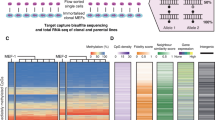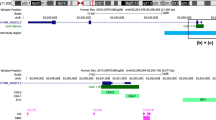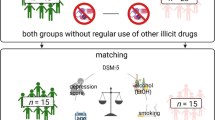Abstract
The μ-opioid receptor is the site of action of opiates and opioids. We examined whether there are differences in cytosine:guanine (CpG) dinucleotide methylation in the OPRM1 promoter between former heroin addicts and controls. We analyzed methylation at 16 CpG dinucleotides in DNA obtained from lymphocytes of 194 Caucasian former severe heroin addicts stabilized in methadone maintenance treatment and 135 Caucasian control subjects. Direct sequencing of bisulfite-treated DNA showed that the percent methylation at two CpG sites was significantly associated with heroin addiction. The level of methylation at the −18 CpG site was 25.4% in the stabilized methadone-maintained former heroin addicts and 21.4% in controls (p=0.0035, generalized estimating equations (GEE); p=0.0077, t-test; false discovery rate (FDR)=0.048), and the level of methylation at the +84 CpG dinucleotide site was 7.4% in cases and 5.6% in controls (p=0.0095, GEE; p=0.0067, t-test; FDR=0.080). Both the −18 and the +84 CpG sites are located in potential Sp1 transcription factor-binding sites. Methylation of these CpG sites may lead to reduced OPRM1 expression in the lymphocytes of these former heroin addicts.
Similar content being viewed by others
Log in or create a free account to read this content
Gain free access to this article, as well as selected content from this journal and more on nature.com
or
References
Abdolmaleky HM, Cheng KH, Russo A, Smith CL, Faraone SV, Wilcox M et al (2005). Hypermethylation of the reelin (RELN) promoter in the brain of schizophrenic patients: a preliminary report. Am J Med Genet B Neuropsychiatr Genet 134B: 60–66.
Alikhani-Koopaei R, Fouladkou F, Frey FJ, Frey BM (2004). Epigenetic regulation of 11 beta-hydroxysteroid dehydrogenase type 2 expression. J Clin Invest 114: 1146–1157.
Andria ML, Simon EJ (1999). Localization of promoter elements in the human mu-opioid receptor gene and regulation by DNA methylation. Brain Res Mol Brain Res 70: 54–65.
Antequera F, Bird A (1993). Number of CpG islands and genes in human and mouse. Proc Natl Acad Sci USA 90: 11995–11999.
Azaryan AV, Clock BJ, Rosenberger JG, Cox BM (1998). Transient upregulation of mu opioid receptor mRNA levels in nucleus accumbens during chronic cocaine administration. Can J Physiol Pharmacol 76: 278–283.
Bailey A, Gianotti R, Ho A, Kreek MJ (2005). Persistent upregulation of mu-opioid, but not adenosine, receptors in brains of long-term withdrawn escalating dose ‘binge’ cocaine-treated rats. Synapse 57: 160–166.
Bart G, Heilig M, LaForge KS, Pollak L, Leal SM, Ott J et al (2004). Substantial attributable risk related to a functional mu-opioid receptor gene polymorphism in association with heroin addiction in central Sweden. Mol Psychiatry 9: 547–549.
Benjamini Y, Hochberg Y (1995). Controlling the false discovery rate: a practical and powerful approach to multiple testing. J Roy Stat Soc Ser B 57: 289–300.
Black YD, Maclaren FR, Naydenov AV, Carlezon Jr WA, Baxter MG, Konradi C (2006). Altered attention and prefrontal cortex gene expression in rats after binge-like exposure to cocaine during adolescence. J Neurosci 26: 9656–9665.
Bleich S, Lenz B, Ziegenbein M, Beutler S, Frieling H, Kornhuber J et al (2006). Epigenetic DNA hypermethylation of the HERP gene promoter induces down-regulation of its mRNA expression in patients with alcohol dependence. Alcohol Clin Exp Res 30: 587–591.
Bonsch D, Lenz B, Fiszer R, Frieling H, Kornhuber J, Bleich S (2006). Lowered DNA methyltransferase (DNMT-3b) mRNA expression is associated with genomic DNA hypermethylation in patients with chronic alcoholism. J Neural Transm 113: 1299–1304.
Bonsch D, Lenz B, Kornhuber J, Bleich S (2005). DNA hypermethylation of the alpha synuclein promoter in patients with alcoholism. Neuroreport 16: 167–170.
Bonsch D, Lenz B, Reulbach U, Kornhuber J, Bleich S (2004). Homocysteine associated genomic DNA hypermethylation in patients with chronic alcoholism. J Neural Transm 111: 1611–1616.
Chahrour M, Zoghbi HY (2007). The story of Rett syndrome: from clinic to neurobiology. Neuron 56: 422–437.
Douet V, Heller MB, Le Saux O (2007). DNA methylation and Sp1 binding determine the tissue-specific transcriptional activity of the mouse Abcc6 promoter. Biochem Biophys Res Commun 354: 66–71.
Gardiner-Garden M, Frommer M (1987). CpG islands in vertebrate genomes. J Mol Biol 196: 261–282.
Gorelick DA, Kim YK, Bencherif B, Boyd SJ, Nelson R, Copersino M et al (2005). Imaging brain mu-opioid receptors in abstinent cocaine users: time course and relation to cocaine craving. Biol Psychiatry 57: 1573–1582.
Grayson DR, Jia X, Chen Y, Sharma RP, Mitchell CP, Guidotti A et al (2005). Reelin promoter hypermethylation in schizophrenia. Proc Natl Acad Sci USA 102: 9341–9346.
Halekoh U, Hojsgaard S (2006). The R package geepack for generalized estimating equations. J Stat Software 15: 1–11.
Iguchi-Ariga SM, Schaffner W (1989). CpG methylation of the cAMP-responsive enhancer/promoter sequence TGACGTCA abolishes specific factor binding as well as transcriptional activation. Genes Dev 3: 612–619.
Issa JP, Kantarjian H (2005). Azacitidine. Nat Rev Drug Discov Suppl: S6–S7.
Jaenisch R, Bird A (2003). Epigenetic regulation of gene expression: how the genome integrates intrinsic and environmental signals. Nat Genet 33: 245–254.
Kreek MJ (2006). Endorphins, gene polymorphisms, stress responsivity, and special addictions: selected topics. In: Madras BK, Colvis CM, Pollock JD, Rutter JL, Shurtleff D, von Zastrow M (eds). Cell Biology of Addiction. Cold Spring Harbor Laboratory Press: Cold Spring Harbor. pp 63–92.
Kreek MJ, Bart G, Lilly C, LaForge KS, Nielsen DA (2005). Pharmacogenetics and human molecular genetics of opiate and cocaine addictions and their treatments. Pharmacol Rev 57: 1–26.
Kumar A, Choi KH, Renthal W, Tsankova NM, Theobald DE, Truong HT et al (2005). Chromatin remodeling is a key mechanism underlying cocaine-induced plasticity in striatum. Neuron 48: 303–314.
Leri F, Zhou Y, Goddard B, Cummins E, Kreek MJ (2006). Effects of high-dose methadone maintenance on cocaine place conditioning, cocaine self-administration, and mu-opioid receptor mRNA expression in the rat brain. Neuropsychopharmacology 31: 1462–1474.
Lewin J, Schmitt AO, Adorjan P, Hildmann T, Piepenbrock C (2004). Quantitative DNA methylation analysis based on four-dye trace data from direct sequencing of PCR amplificates. Bioinformatics 20: 3005–3012.
Marutha Ravindran CR, Ticku MK (2005). Role of CpG islands in the up-regulation of NMDA receptor NR2B gene expression following chronic ethanol treatment of cultured cortical neurons of mice. Neurochem Int 46: 313–327.
McCarthy L, Szabo I, Nitsche JF, Pintar JE, Rogers TJ (2001). Expression of functional mu-opioid receptors during T cell development. J Neuroimmunol 114: 173–180.
McLellan AT, Luborsky L, Woody GE, O’Brien CP (1980). An improved diagnostic evaluation instrument for substance abuse patients. The Addiction Severity Index. J Nerv Ment Dis 168: 26–33.
Michelotti GA, Brinkley DM, Morris DP, Smith MP, Louie RJ, Schwinn DA (2007). Epigenetic regulation of human alpha1d-adrenergic receptor gene expression: a role for DNA methylation in Sp1-dependent regulation. FASEB J 21: 1979–1993.
Miller CA, Sweatt JD (2007). Covalent modification of DNA regulates memory formation. Neuron 53: 857–869.
Peles E, Kreek MJ, Kellogg S, Adelson M (2006). High methadone dose significantly reduces cocaine use in methadone maintenance treatment (MMT) patients. J Addict Dis 25: 43–50.
Phiel CJ, Zhang F, Huang EY, Guenther MG, Lazar MA, Klein PS (2001). Histone deacetylase is a direct target of valproic acid, a potent anticonvulsant, mood stabilizer, and teratogen. J Biol Chem 276: 36734–36741.
Philibert RA, Gunter TD, Beach SR, Brody GH, Madan A (2008). MAOA methylation is associated with nicotine and alcohol dependence in women. Am J Med Genet B Neuropsychiatr Genet 147B: 565–570.
Renthal W, Maze I, Krishnan V, Covington III HE, Xiao G, Kumar A et al (2007). Histone deacetylase 5 epigenetically controls behavioral adaptations to chronic emotional stimuli. Neuron 56: 517–529.
Rettig RA, Yarmolinsky A (eds) (1995). Federal Regulation of Methadone Treatment. National Academy Press: Washington, DC.
Schug J, Overton GC (1977). TESS: Transcription Element Search Software on the WWW.. Computational Biology and Informatics Laboratory, School of Medicine, University of Pennsylvania: Philadelphia.
Unterwald EM, Rubenfeld JM, Kreek MJ (1994). Repeated cocaine administration upregulates kappa and mu, but not delta, opioid receptors. Neuroreport 5: 1613–1616.
Weaver IC, Cervoni N, Champagne FA, D’Alessio AC, Sharma S, Seckl JR et al (2004). Epigenetic programming by maternal behavior. Nat Neurosci 7: 847–854.
Yuferov V, Zhou Y, Spangler R, Maggos CE, Ho A, Kreek MJ (1999). Acute ‘binge’ cocaine increases mu-opioid receptor mRNA levels in areas of the rat mesolimbic mesocortical dopamine system. Brain Res Bull 48: 109–112.
Zhang H, Darwanto A, Linkhart TA, Sowers LC, Zhang L (2007). Maternal cocaine administration causes an epigenetic modification of protein kinase Cepsilon gene expression in fetal rat heart. Mol Pharmacol 71: 1319–1328.
Zhou Y, Bendor J, Hofmann L, Randesi M, Ho A, Kreek MJ (2006). Mu opioid receptor and orexin/hypocretin mRNA levels in the lateral hypothalamus and striatum are enhanced by morphine withdrawal. J Endocrinol 191: 137–145.
Acknowledgements
We thank E Ducat, B Ray, D Melia, L Borg, K Bell, P McHugh, J Schluger, and H Hofflich for recruiting, screening, and assessment of study subjects, and M Randesi for sequencing assistance. We also thank CD Allis for his helpful advice before the start of this project and in the review of this paper, to M Rouault for assistance, and to O Levran for critical review of this paper. This study was supported by National Institutes of Health (NIH) grants R03-DA022266 (DN), K05-DA000049 (MJK), P60-DA005130 (MJK), R01-MH79880 (MJK), RR UL1RR024143 (BC), NIH-MH R01-44292 (JO), and NSFC grants 30730057 and 30700442 from the Chinese Government (JO).
Author information
Authors and Affiliations
Corresponding author
Additional information
DISCLOSURE/CONFLICT OF INTEREST
All the authors, except JO, declare that, except for the income received from our primary employers, no financial support or compensation has been received from any individual or corporate entity over the past 3 years for research or professional service and there are no personal financial holdings that could be perceived as constituting a potential conflict of interests. One author, JO, declares that he personally receives book royalties from the Johns Hopkins University Press and that his laboratory receives funding from Hoffmann-La Roche Inc.
Rights and permissions
About this article
Cite this article
Nielsen, D., Yuferov, V., Hamon, S. et al. Increased OPRM1 DNA Methylation in Lymphocytes of Methadone-Maintained Former Heroin Addicts. Neuropsychopharmacol 34, 867–873 (2009). https://doi.org/10.1038/npp.2008.108
Received:
Revised:
Accepted:
Published:
Issue date:
DOI: https://doi.org/10.1038/npp.2008.108
Keywords
This article is cited by
-
Prenatal opioid-exposed infant extracellular miRNA signature obtained at birth predicts severity of neonatal opioid withdrawal syndrome
Scientific Reports (2022)
-
Effect of short-term prescription opioids on DNA methylation of the OPRM1 promoter
Clinical Epigenetics (2020)
-
An analysis of the effect of mu-opioid receptor gene (OPRM1) promoter region DNA methylation on the response of naltrexone treatment of alcohol dependence
The Pharmacogenomics Journal (2020)
-
Genomewide Study of Epigenetic Biomarkers of Opioid Dependence in European- American Women
Scientific Reports (2019)
-
Racial association and pharmacotherapy in neonatal opioid withdrawal syndrome
Journal of Perinatology (2019)



